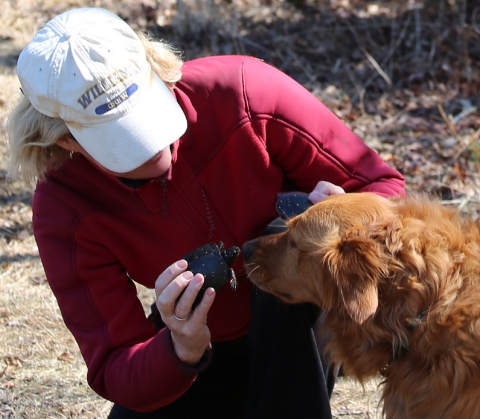Female (Left) and Male Spotted Turtles (Clemmys guttata)
In coastal Massachusetts, spotted turtles (Clemmys guttata) are the first turtle species to awake from winter brumation. Just as ice melts in shallow wetlands, and the March sun rises above the treeline, spotted turtles emerge from their oozy hibernacula and trek to nearby mating aggregations. Bright yellow spots on a dark carapace give this species its extremely descriptive name.
Sue Wieber Nourse and Rufus Examine Spotted Turtles
We saw the first active spotteds in a SouthCoast pond on March 18th. On Thursday, April 3rd, the Turtle Journal team investigated a mating aggregation near Washburn Park in Marion. This wetland area had been significantly disrupted by NSTAR within the last year, and we wondered whether spotteds would return this season. We sneaked up on the site and peered through trees and brambles into the swampy wetlands. Sue Wieber Nourse observed two turtles under water cavorting in mating show, and Don Lewis saw another turtle about ten feet further down the trail basking on downed branches.
Female (Left) and Male Spotted Turtles (Clemmys guttata)
We charged through thick brush and managed to capture two of the three turtles; one gorgeous female and a very handsome male. Both were first time captures. The female weighed 125 grams and measured 9.16 centimeters long. She sported the most lovely galaxy of yellow spots on her carapace. The male weighed 148 grams and measured 10.02 centimeters long.
Female (Left) and Male Spotted Turtles (Clemmys guttata)
Spotteds are a small, extremely beautiful wetlands turtle. Females can be distinguished by brightly colored yellow-orange necks, while males have drab gray or dark colored necks. To compensate for such drab colors, males have a thick, showy tail. As illustrated above, males also have an indentation on the plastron across their abdominals; females to the contrary have flat, washboard abs.



